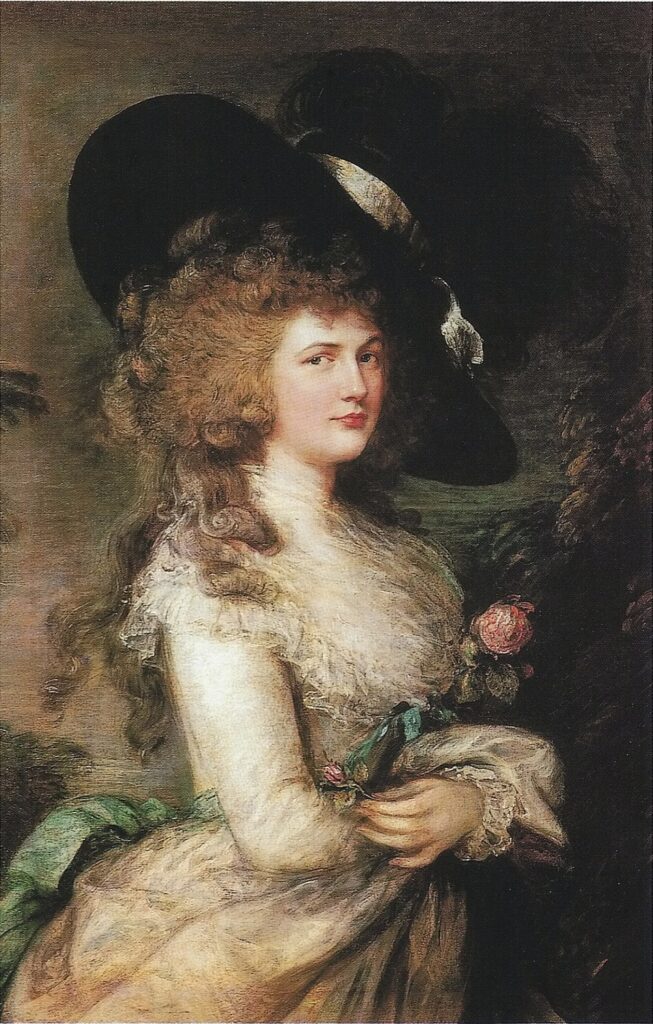
This blog is part of series linked to our exhibition, More than Pretty, which looks at body decoration of girls throughout history. Check out the exhibition here.
The Georgian period has become more popular recently with figures like Georgiana, Duchess of Devonshire showcasing the glamorous life of elite Britain, but what was it really like to live in as girl? By this time makeup had become much more affordable, which meant more girls from the lower and middle classes were able to buy or make their own cosmetics. The ideal Georgian girl would have snow white skin, a high forehead, dark eyebrows, plump rosy cheeks, small lips that looked like a rosebud with a full set of white teeth, and big hair full of waves and curls. The key part of the look is hair – the bigger the better! Big hair was time consuming to create and maintain, which meant that washing and bathing was not a common practice in the Georgian period. Faces and hands would have been washed daily, but having a bath was not considered healthy. Hair was also not washed frequently. Most sources report that washing hair every second week with soap and water was enough. If you brushed your hair regularly you could wash it even less than this! Most girls would comb their hair first, then brush it to remove what the comb did not. Then you would use curling irons to add curls and waves if your hair was naturally straight. Domed or egg-shaped hair ups were popular, the taller the better as the century went on. Hair was piled over wire or pads to create more height and you could even buy horse hair pieces if you didn’t have enough natural hair. Rosemary water or tea was used as hair spray to keep styles in place. These took hours to arrange and were costly to maintain so were worn for several weeks, hence the lack of washing. Some girls would have had to sleep sitting up to maintain these styles if they did not have specially made nightcaps to cover the creations.
With all that work done on your hair, girls would move on to their face. Dark eyebrows were in in a half-moon shape with tapered ends. You could darken them with kohl, burnt cork, lampblack or elderberries. If you had no hair due to lead poisoning (because most cosmetics at this time were poisonous), you could draw on eyebrows or catch a mouse and use the fur to make some. A solution for everything! Eyes were left without makeup, but some redness would have been natural due to all the lead-based face powders covering the skin. These face powders were not supposed to look natural, which is why they were referred to as paint. Sometimes girls would draw on veins with blue pencils to enhance white even further. But you also didn’t wanted to look unwell, so a little rouge would be applied on the cheeks. A half circle shape would be applied from the corner of your eye down to the mouth around the cheek bones. The upper classes preferred red rouge for this and the middle classes pink powder. The red or pink colours came from vermillion with mercury (toxic), creuse with vinegar, safflower, sandalwood, brazilwood and wood resin. A little colour was also added to the lips. For the first time, a variety of colours were popular from red and burgundy to pink and coral. Distilled alcohol or vinegar with shades of pomades would be applied to get the desirable colour. To finish off your look you could add a beauty patch, usually made from satin, silk, taffeta or velvet. These would be applied to many places on the face and they could be of various sizes and shapes, whatever was fashionable at the time. Finally, it was time to go to the drawing room to receive callers.
In the next installment, we see what the Regency period was like.
-Monique Brough
Curator
Girl Museum Inc.
For more information, check out
http://www.express.co.uk/entertainment/books/494198/10-shocking-facts-about-Georgian-women
http://hibiscus-sinensis.com/regency/cosmetics.htm
http://demodecouture.com/hairstyles-cosmetics-18th-century/
http://hair-and-makeup-artist.com/womens-regency-makeup/
https://www.geriwalton.com/georgian-hair-womans-crowning-glory-and/
